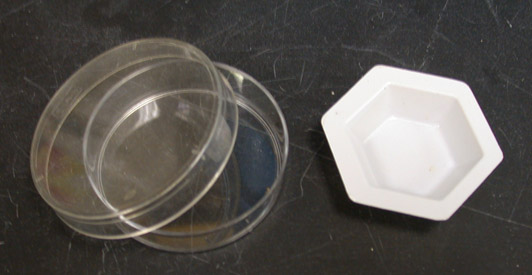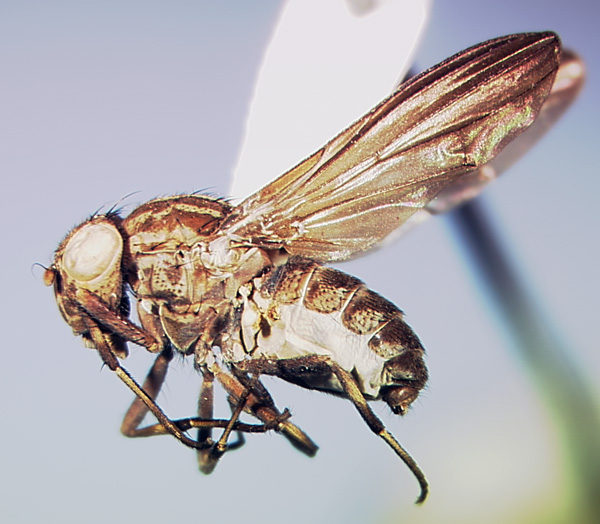– Dominique Orozco & Stephen Gaimari
At the California State Collection of Arthropods, we use HMDS (after Brown, 1993) as our regular method for processing Diptera and other insects from alcohol. Rather than processing piecemeal (i.e., a couple samples at a time), we do higher through-put processing of 50-100 samples in a given day. Of course, once the procedure is done, it takes some time to get the samples mounted before the next run. Here we outline the specific procedures we have used with excellent results, just to provide a little extra guidance, although our methods don’t differ substantially from Brown (1993).


- Small plastic Petri dishes with covers (we use Falcon Petri dishes, #1007, 60x15)
- Weighing boats (we use Daigger disposable polystyrene Weigh Dishes, small, #EF14251A, 1X1.5”)
- Trays to hold numerous Petri dishes (we use trays that fit about 20-40 Petri dishes each)
- Hexamethyldisilizane (HMDS – we use the Sigma-Aldrich, standard grade, #H4875 – the other grades are very expensive and the results do not differ). HMDS should be stored in a refrigerator dedicated to chemical storage. Note, HMDS is a dangerous chemical, and any user should be very familiar with the Material Safety Data Sheet.
- Empty HMDS bottles for “used” and “2nd used” HMDS. As explanation, starting with fresh HMDS, it can be reused twice for the first soaking step (never for the overnight evaporation step) before being discarded. That is, fresh HMDS used in the first soak can be transferred to the “used” bottle; “used” HMDS used for the first soak can be transferred to “2nd used” bottle; “2nd used” HMDS used for the first soak is to be discarded after use.
Setup
- The weighing boats are placed into the Petri dishes (because the sample will be in the weighing boat, this allows the locality label to be placed between the weigh boat and the Petri dish to avoid soaking the label in HMDS
- Numerous Petri dishes with weighing boats are placed on as many trays as needed
- All work should take place in a Fume hood
- Always use gloves when dealing with HMDS
Protocol
- Specimens should be fully dehydrated in 100% EtOH (i.e., use an ethanolic step series to bring the sample to 100% EtOH). All water must be removed from the specimens because HMDS contact with water produces ammonia gas.
- Carefully transfer specimens (they can be rather brittle in 100% EtOH) into weighing boats, by gently pouring or pulling out with forceps. Sometimes samples need to be split among weighing boats if there are too many specimens to avoid crowding. EtOH should be changed to fresh 100% EtOH. Replace the lid onto the Petri dish.
- After all transfers have been made for ONE ROW, go back to the first dish and remove the 100% EtOH (with syringe/pipette) and immediately replace with “used” or “2nd used” HMDS. Replace the cover on the Petri dish and go to the next one. Once a single row of Petri dishes have been finished, record the time to keep from having samples sit in chemistry for too long or too short a period of time.
- Let samples sit for 2 hours.
- Remove used HMDS (transferring into either “used,” “2nd used,” or “discard” bottles) from first dish of specimens and replace with fresh HMDS immediately. Leave cover off specimens over night and allow to evaporate. (note, for larger flies, it is best to repeat step 3 before the overnight soak).
- In the morning, return lids to the Petri dishes to keep specimens covered until they can be mounted.
- Mount away!! Following is an example of a specimen prepared with this method (Lauxaniidae: Tauridion shewelli Papp & Silva)


References
Brown, B.V. 1993. A further chemical alternative to critical- point-drying for preparing small (or large) flies. Fly Times 11: 10.
Note: We don’t specifically endorse the products above. We are just providing the specifics of what we use.
Report a Pest
Entomology Sub-Menu
Plant Pest Diagnostics Center
CDFA Collections
General Info/Links
Contact Us
Plant Pest Diagnostics Center & Entomology Laboratory
3294 Meadowview Road
Sacramento, CA 95832
Phone: (916) 262-1100
Fax: (916) 262-1190
Map & Directions
